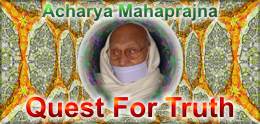
Existence has many attributes. Some expressed, some not expressed. The question arises "is grass also clarified butter?" The answer would be that there is clarified butter within the grass but it is not fully expressed. Does milk have clarified butter? Yes, it does but it is not fully expressed. When the fat from the milk is extracted then butter can be reclaimed. That which was not expressed now becomes expressed. Substance has two types of strength - general (ogh) and particular (samuchit). The ogh is the governing energy. On its basis the law of cause and effect is established. The cause is always harmonious with the effect. The cause is not expressed; the effect finds expression. Now you will ask does the grass have clarified butter or not? Answering from the perspective of ogh energy, it has butter. But from the perspective of samuchit energy it does not have. We find colour, smell, taste and touch in all substance, pudgal. The rose flower smells fragrant, but it also has an equal amount of bad smell. The fragrance has found expression while the bad smell has not found expression. Sugar is as bitter as it is sweet. Its sweetness has found expression not its bitterness. There is fragrance in rot as there is stench.
The king Jitashatru was going out of town. His minister Subudhi was with him. He crossed a canal. It was full of garbage. Corpses of animals were rotting in it. The stench from it was unbearable. The King blocked his nose with his handkerchief. "What a stench!" The King told the minister. The minister was a philosopher. He said, Sir, This is the nature of matter. He was able to reduce the disgust being experienced by the King. The matter ended there. After some days, the minister invited the King home for a meal. The King drank a glass of water. It was sweet, very clear, and very fragrant. The King said, "Minister, where did you get this water from? I want to drink one more glass of water. I do not think of you as different from me, but you obviously do not think so about me. You drink such nice water but you never get it for me." The minister smiled and then said, "Sir, I bring this water from that canal the stench of which you could not bear." The King said this couldn’t happen. How can this water be from there? The minister stood his ground. The King wanted proof. The minister asked for a glass of water from the canal. As the King watched the water was brought. It was as pure, as sweet and as fragrant as the King has drunk in the minister's house. Not only water, everything changes. The cycle of change is forever on. And all objects can keep changing. From the perspective of ogh energy, we cannot label any object as black or yellow, bitter or sweet, fragrant or otherwise, oily or dry, cold or hot, light or heavy, soft or hard. A neem leaf has all the attributes that are found in the world. But from the samuchit perspective, it is not so. From that perspective, a neem leaf is moist and green. It has its own perfume, it is light and delicate. All our knowledge is empirical and subjective.
A number of events take place in every object through transformation. Energy may increase or decrease. Energy is expressed through change. The famous scientist Einstein established the principle that mass can be converted into energy. This principle of equivalence of mass and energy can only be explained through the principle of changing permanence. Before Einstein, the world of classical physics believed that matter cannot be changed into energy or vice - versa. After Einstein this theory changed. It was accepted that matter and energy are not different but the transformations of a single reality. If one pound of coal is taken and its mass is converted into energy then two billion kilowatts of electricity can be obtained.
According to Jain philosophy, substance has infinite energy, whether it is soul or matter. In the infinite flow of time only that substance can be in existence, which has infinite energy.
This energy is expressed through change. Today the world of science is basing all its experiments in the world of pudgal. Matter can be reduced to that state where its gross attributes disappear, its mass disappears and what remains is in the form of energy. Jain philosophy has explained the world in terms of substantial (dravyarthik) and modal (paryayarthik) nay or perspectives. When we look at the world from the perspective of identity (abedh) we see only substance. Neem, house, man, animal are all different expressions of substance. When we look at the world from the perspective of differences (bedh) then all matter disappears and we see only modes and modes. Change and more change. What is man? He is not a substance. What is he? Even if you search the world you will not get any substance in the name of man. Man is a mode. Neem is not a substance - it is a mode. All the objects we see in this world are modes none of them are substances. Substance does not come before us. It remains imperceptible. Acharya Hemchandra expressed this truth in the following words:
Aparyayam vastu samasyaman
Madravyametachcha vivichiyamanam
When we look at things from the perspective of abedh, then modes disappear and everything is substance. Our world will be very small. Expanse will be nullified. If we look "at differences then substance disappears and what remains are the modes. Our world becomes very expansive. Differences will swallow up the similarity. There will be only expansion and more expansion.
As far as transformation is concerned both soul and matter have to undergo transformation but the expression pudgal has found in this world, nothing else has. The protean capacity to change which pudgal has, nothing else has. If there is any fundamental substance for the manifested form of modes it is pudgal.
 Acharya Mahaprajna
Acharya Mahaprajna


